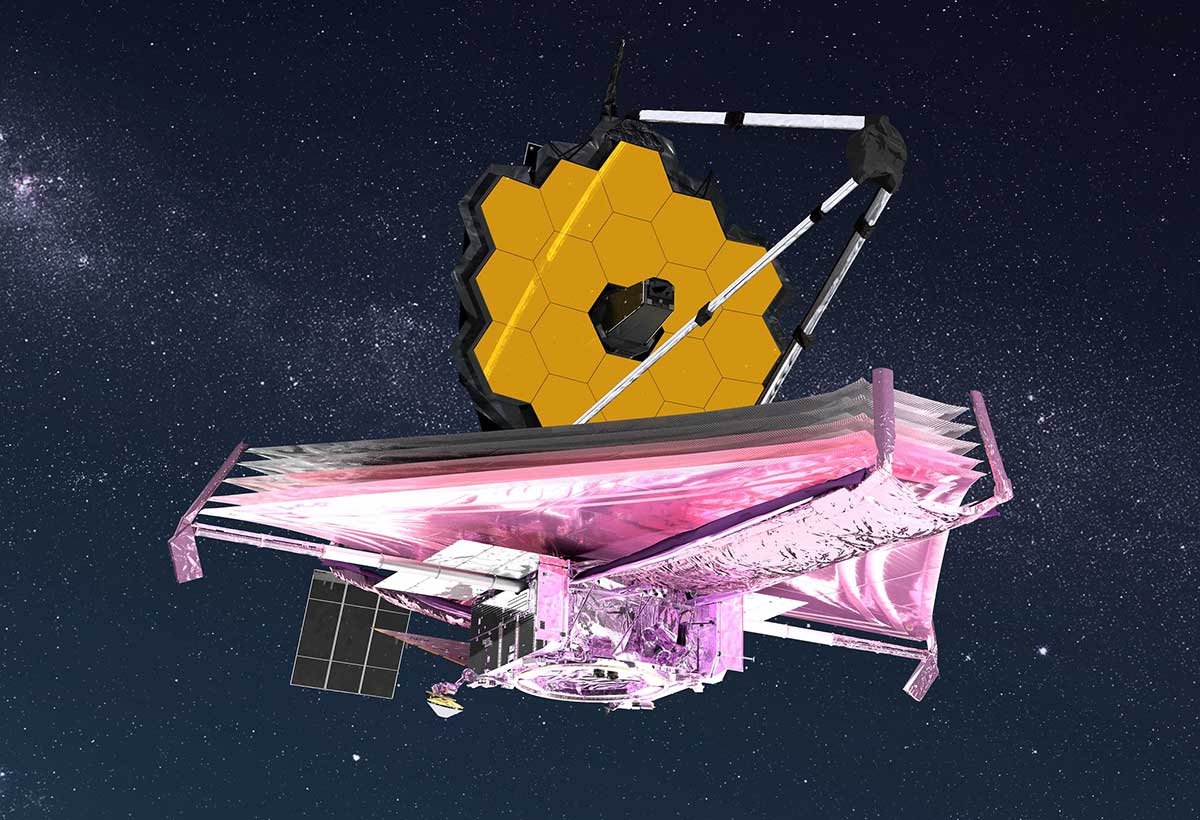The most exciting advancement in recent years is the James Webb Space Telescope (JWST), a monumental achievement in astronomical technology in astronomical technology. With its innovative design and unparalleled observational power, the JWST promises to revolutionize our understanding of the universe. This article delves into the journey of the JWST, from its conception to its future prospects, and explores the excitement it brings to the world of astronomy.
Table of Contents
ToggleHow did the idea of James Webb Space Telescope emerge?
The concept of the JWST emerged in the early 1990s, building on the successes and limitations of the Hubble Space Telescope. Hubble had opened our eyes to the universe in unprecedented ways, but it also highlighted the need for even more advanced observational tools. Scientists and engineers envisioned a telescope that could peer deeper into space and further back in time, capturing the light from the first galaxies that formed after the Big Bang.
The idea was ambitious: a telescope that would operate primarily in the infrared spectrum, allowing it to see through cosmic dust and observe the most distant and ancient objects in the universe. This would require a telescope with a much larger mirror than Hubble’s, capable of capturing more light and providing higher resolution images. Thus, the vision for the JWST was born.
Building the James Webb Space Telescope
Constructing the JWST was a feat of engineering and international collaboration. Led by NASA, with significant contributions from the European Space Agency (ESA) and the Canadian Space Agency (CSA), the project brought together thousands of scientists, engineers, and technicians from around the world. This wasn’t just about building a bigger telescope; it required pushing the boundaries of technology and engineering to create an instrument capable of operating in the harsh conditions of space while maintaining unprecedented levels of precision.
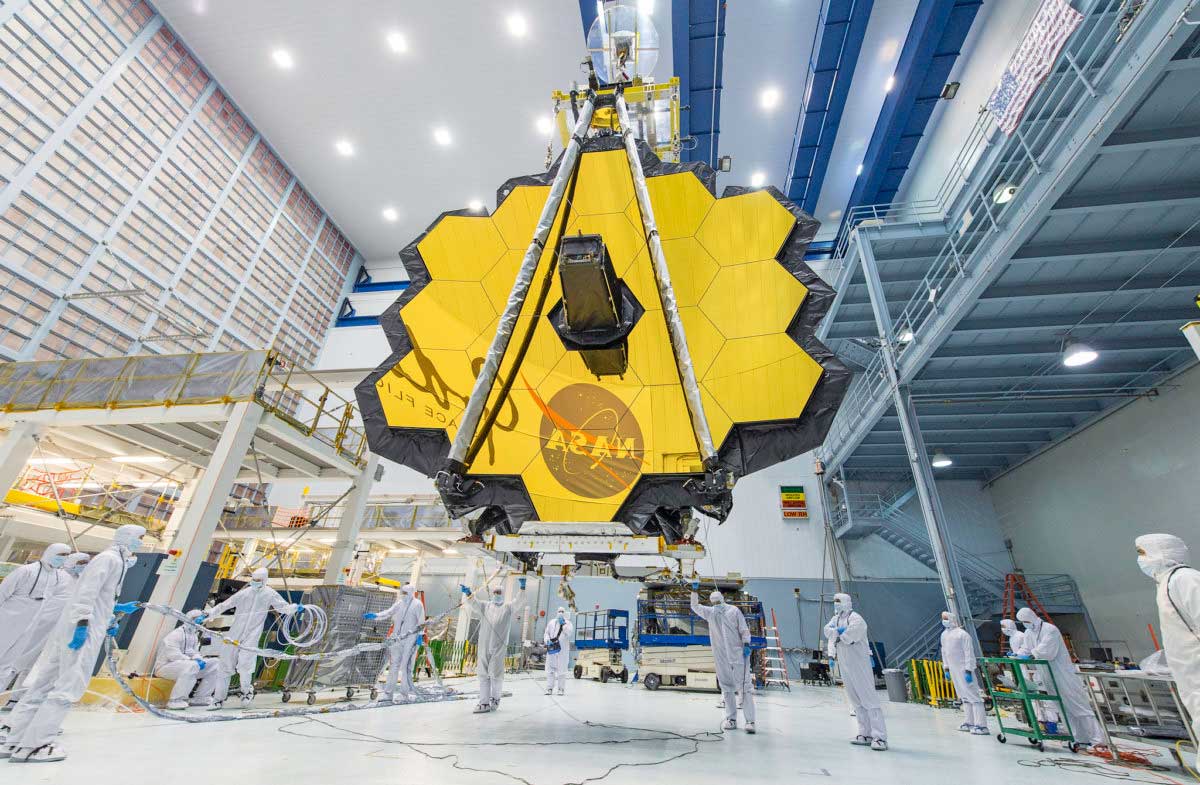
Design and Components
The JWST’s primary mirror is its most striking feature. Composed of 18 hexagonal segments made of beryllium and coated with a thin layer of gold, the mirror has a total diameter of 6.5 meters (21.3 feet). This large size allows the telescope to collect more light, enabling it to observe faint and distant objects with unprecedented clarity.
One of the key challenges in building the JWST was ensuring that the mirror could be folded to fit inside the launch vehicle and then precisely deployed in space. The segments were meticulously engineered to unfold and align with nanometer precision once the telescope reached its destination.
The JWST is equipped with four main scientific instruments:
-
Near Infrared Camera (NIRCam):
Captures images in the near-infrared spectrum (0.6 to 5 micron range), crucial for observing distant galaxies and stellar nurseries.
-
Near Infrared Spectrograph (NIRSpec):
Capable of analyzing the light from hundreds of objects simultaneously, providing detailed information about their composition and properties. It is used for spectroscopy in the 0.6 to 5 micron range
-
Mid-Infrared Instrument (MIRI):
Extends the telescope’s observation capabilities into the mid-infrared range, ideal for studying cooler objects like dust-enshrouded stars and exoplanets. Capable for imaging and spectroscopy in the 5 to 28 micron range
-
Fine Guidance Sensor/Near InfraRed Imager and Slitless Spectrograph (FGS/NIRISS):
Ensures precise pointing of the telescope and conducts observations of exoplanets and distant galaxies.
Sunshield and Cooling System
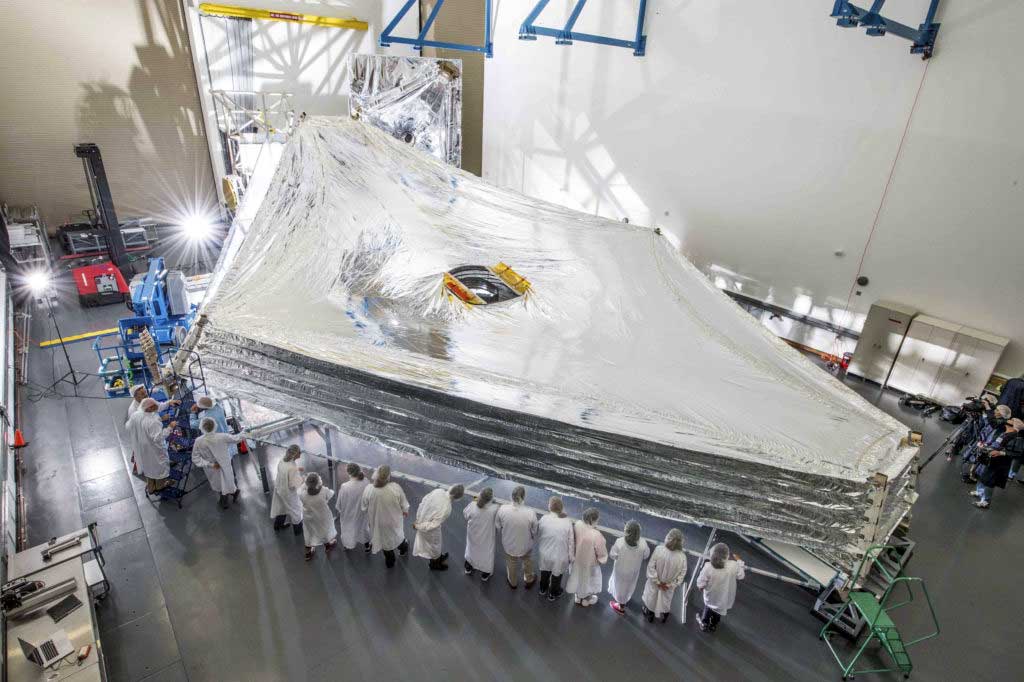
To achieve its mission, the JWST must operate at extremely cold temperatures, around 40 Kelvin (-233°C or -388°F). This is necessary to prevent the telescope’s own heat from interfering with its infrared observations. To accomplish this, the JWST is equipped with a five-layer sunshield made up of special heat-resistant material called Kapton, roughly the size of a tennis court, which blocks heat from the Sun, Earth, and Moon. Additionally, the telescope’s instruments are cooled by a cryocooler system, ensuring they remain at optimal temperatures.
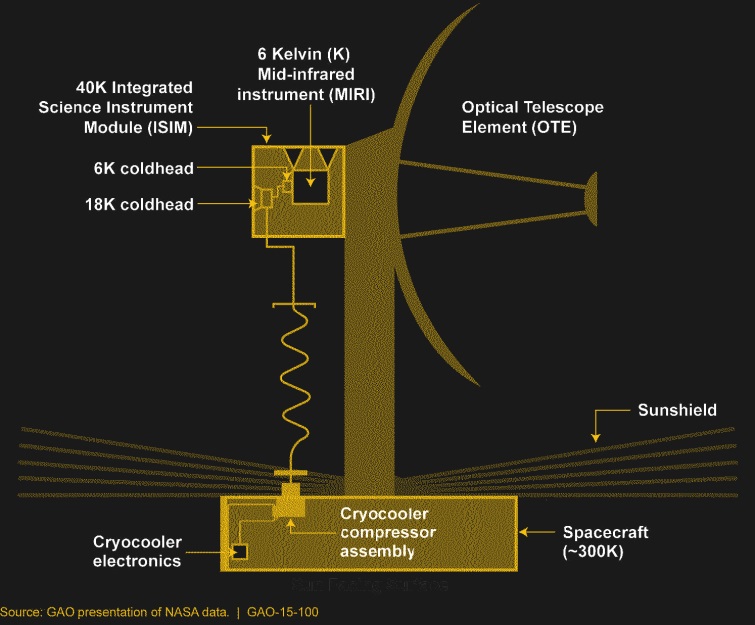
The JWST’s Orbit
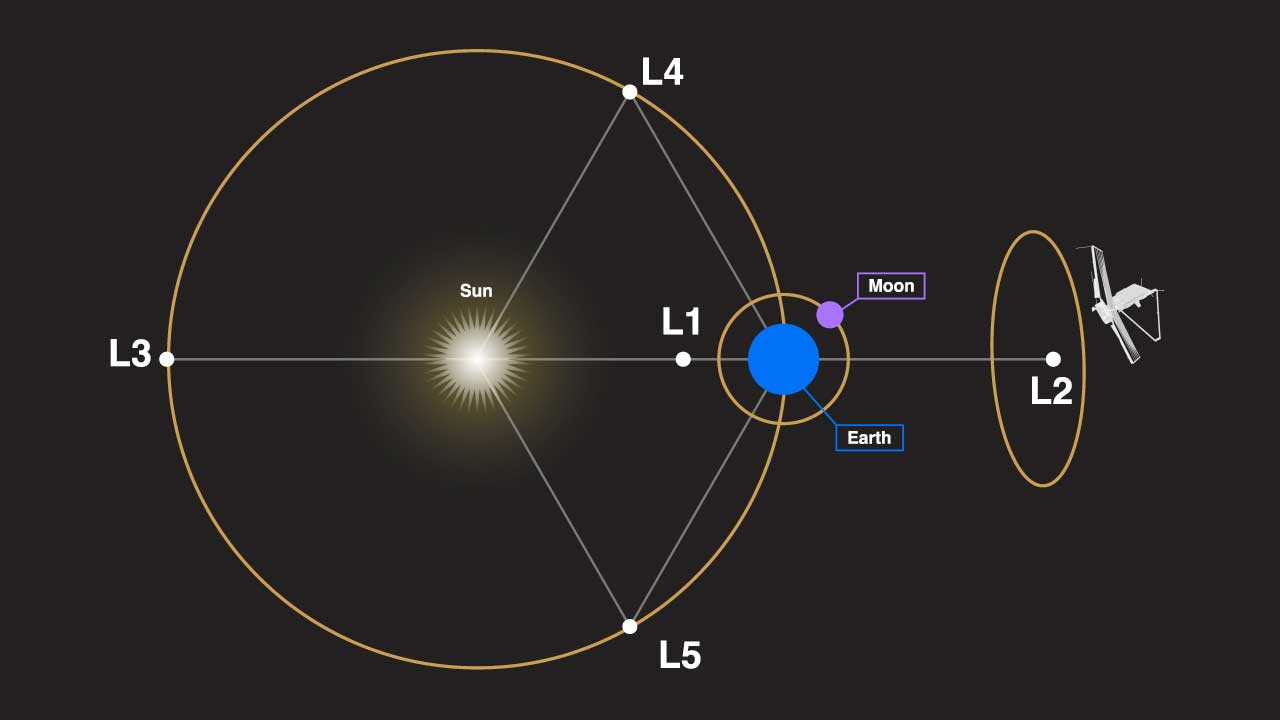
Unlike the Hubble Space Telescope, which orbits the Earth, the JWST is positioned at the second Lagrange point (L2), located about 1.5 million kilometers (1 million miles) from Earth. This orbit offers several advantages:
-
Stable Environment:
L2 provides a stable gravitational environment, reducing the need for frequent adjustments.
-
Constant Sunshield Orientation:
The JWST can maintain a fixed orientation relative to the Sun, Earth, and Moon, keeping its sunshield effectively positioned to block heat and light.
-
Unobstructed View:
The telescope has a clear and continuous view of the cosmos, enabling long-duration observations without the interruptions caused by Earth’s shadow or atmospheric interference.
-
Fuel Efficiency:
The stable orbit requires minimal fuel for station-keeping, extending the telescope’s operational lifespan.
-
Thermal Stability:
The consistent positioning relative to the Sun enables better thermal management, crucial for infrared observations.
Magnification Power and Observational Capabilities
The JWST’s magnification power and observational capabilities are nothing short of extraordinary. Its primary mirror, combined with advanced instruments, allows it to achieve resolutions and sensitivities far superior to any previous space telescope.
The James Webb Space Telescope enormous primary mirror, with a collecting area about 6.25 times larger than Hubble’s, allows it to gather significantly more light. This, combined with its advanced sensors and its position far from Earth’s interfering heat and light, enables the JWST to detect incredibly faint signals from the most distant reaches of the observable universe. The sensitivity of JWST can be understood as it can detect the equivalent of a single firefly at the distance of the Moon.
Infrared Observations
By operating primarily in the infrared spectrum, the JWST can peer through cosmic dust clouds that often obscure visible light. This capability is crucial for studying regions where stars and planets are forming, as well as for observing the faint light from the earliest galaxies. Infrared observations also enable the study of exoplanet atmospheres, providing insights into their composition and potential habitability.
Spectroscopy
Spectroscopy is a powerful tool for understanding the properties of astronomical objects. By analyzing the light from stars, galaxies, and other celestial bodies, scientists can determine their chemical composition, temperature, velocity, and more. The JWST’s spectrographs, such as NIRSpec and NIRISS, will revolutionize our ability to conduct detailed spectral analysis of distant objects.
Imaging
The JWST’s imaging capabilities, particularly through NIRCam and MIRI, will produce stunningly detailed images of the universe. From the intricate structures of nebulae to the delicate features of distant galaxies, the JWST will capture the cosmos in breathtaking clarity. These images will not only advance scientific knowledge but also inspire the public and ignite a sense of wonder about the universe.
These specifications make the JWST about 100 times more powerful than the Hubble Space Telescope, allowing it to see farther into space and further back in time than ever before.
Discoveries and Early Results
Since its launch on December 25, 2021, and its successful deployment and commissioning, the JWST has already begun to deliver groundbreaking results. Some of the early discoveries and observations include:
First Light and Early Galaxies
One of the JWST’s primary goals is to observe the first galaxies that formed after the Big Bang. Early observations have revealed some of the most distant galaxies ever seen, providing insights into the universe’s infancy. By studying these ancient galaxies, scientists hope to understand the processes that led to the formation of stars, galaxies, and other cosmic structures. Recently JWST has discovered the most distant black hole collision
Exoplanet Atmospheres
The JWST has also begun to study the atmospheres of exoplanets, revealing their chemical compositions and potential habitability. For example, the telescope detected water vapor in the atmosphere of a distant exoplanet, providing clues about the presence of liquid water and the possibility of life. These observations will help us understand the diversity of planetary systems and the potential for life beyond our solar system.
How it studies exoplanet atmosphere?
-
Transit Method
- As an exoplanet passes in front of its star, it causes a tiny dip in the star’s brightness.
- The JWST’s sensitive instruments can detect these minute changes, allowing it to confirm the existence of exoplanets.
-
Atmospheric Analysis
- During a transit, some of the star’s light passes through the exoplanet’s atmosphere.
- Different elements and compounds in the atmosphere absorb specific wavelengths of light.
- By analyzing the spectrum of light that reaches the telescope, scientists can determine the composition of the exoplanet’s atmosphere.
-
Direct Imaging
- For some larger, brighter exoplanets, the JWST can potentially capture direct images.
- Its coronagraph can block out the bright light of a star, allowing the much fainter planet to be seen.
-
Thermal Emission
- The JWST’s infrared capabilities allow it to detect heat signatures from exoplanets.
- This can provide information about a planet’s temperature and potentially its atmospheric circulation.
How JWST is searching for Life?
The James Webb Space Telescope’s advanced capabilities make it a powerful tool in the search for extraterrestrial life. Here’s how it contributes to this quest:
-
Biosignatures
- The JWST can detect potential biosignatures – chemical markers that might indicate the presence of life.
- These could include gases like oxygen, methane, and carbon dioxide in specific combinations.
-
Habitable Zone Planets
- The telescope can study planets in the “habitable zone” of their stars, where liquid water could exist on the surface.
- It can analyze the atmospheres of these planets for conditions conducive to life as we know it.
-
Organic Compounds
- The James Webb Space Telescope’s spectroscopic capabilities allow it to detect complex organic molecules, which could be precursors to life.
-
Atmospheric Disequilibrium
- Life tends to create chemical disequilibrium in a planet’s atmosphere.
- The JWST can potentially detect these imbalances, which could be indicative of biological processes.
-
Water Worlds
- The telescope can identify water vapor in exoplanet atmospheres, helping to locate potentially habitable “water worlds.”
Stellar Nurseries
The JWST’s infrared capabilities allow it to peer into stellar nurseries, regions where new stars are forming. Early observations have captured stunning images of these cosmic birthplaces, revealing the intricate details of star formation and the processes that shape young stars and planetary systems.
Future Expectations and Potential Discoveries
The JWST’s mission is just beginning, and its future holds immense promise for advancing our understanding of the universe. Here are some of the exciting areas of research and potential discoveries that lie ahead:
Dark Matter and Dark Energy
One of the biggest mysteries in cosmology is the nature of dark matter and dark energy, which together make up about 95% of the universe’s mass-energy content. The James Webb Space Telescope observations of galaxy clusters and cosmic structures will provide valuable data to help unravel these enigmatic components of the universe. By studying the distribution and behavior of dark matter and dark energy, scientists hope to gain insights into their properties and their role in the evolution of the cosmos.
Formation of Stars and Planets
The JWST will continue to explore the processes of star and planet formation, providing detailed observations of protoplanetary disks and young stellar objects. By studying these early stages, scientists can better understand how planetary systems, including our own solar system, come into being. This research will shed light on the conditions necessary for planet formation and the potential for habitable worlds.
Galaxy Evolution
James Webb Space Telescope will trace the evolution of galaxies over cosmic time, from the first galaxies that formed after the Big Bang to the diverse array of galaxies we see today. By observing galaxies at different stages of their development, scientists can piece together the history of galaxy formation and growth. This research will provide insights into the processes that shape galaxies, such as mergers, interactions, and the role of supermassive black holes.
Exploring Our Solar System
While the James Webb Space Telescope is primarily designed for deep-space observations, it will also contribute to our understanding of objects within our solar system. The telescope’s high-resolution imaging and spectroscopic capabilities will enable detailed studies of planets, moons, asteroids, and comets. This research will enhance our knowledge of the composition and dynamics of these objects, providing a more comprehensive picture of our cosmic neighborhood.
References:
